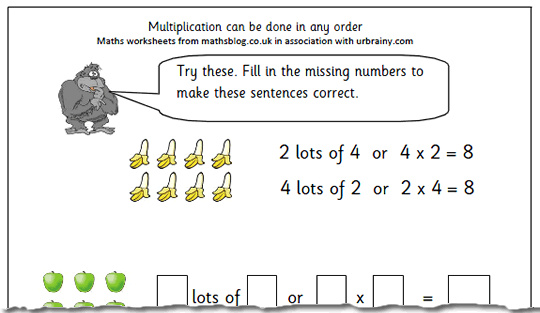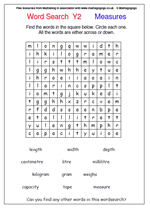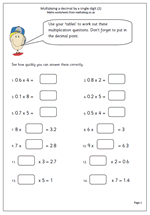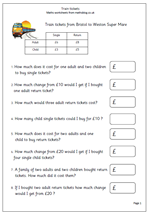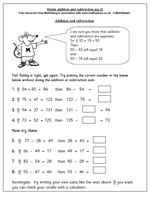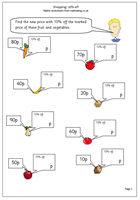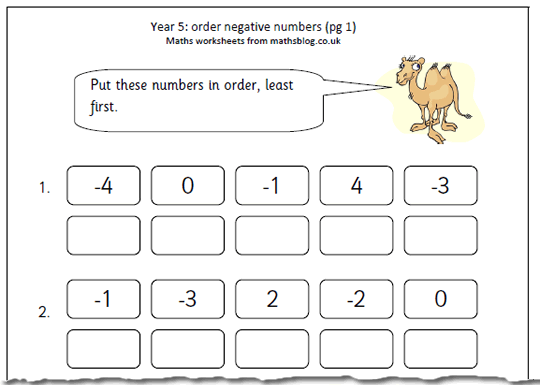Children in Year 2 are expected to know and understand an awful lot about how numbers work. Here we have a maths worksheet, one of a set from urbrainy.com, which looks at a vital part of understanding the process of multiplication: that it can be done in any order. This is also true of addition, but not of subtraction or division.
This page shows that ‘2 lots of 4’ is the same as ‘4 lots of 2’, therefore 4 x 2 is the same as 2 x 4. It does not matter which way the answer is worked out, it will be 8.
This little piece of knowledge helps children with mental arithmetic and with learning tables. Each table which is learned gives further knowledge of other tables. Eg If you know 5 x 4 = 20 then you can quickly reverse the number sentence to 4 x 5 = 20.
Handa’s Surprise by Eileen Browne
Handa’s Surprise by Eileen Browne
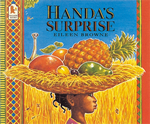 Handa’s Surprise (Walker paperbacks)
Handa’s Surprise (Walker paperbacks)
Handa’s Surprise is a great book for young children – one that they really like to have read to them again and again. As well as being a good story it incorporates some strong maths concepts, including counting, sequencing and subtraction.
Set in Africa there is a warm summery glow to the book with bright illustrations and a range of unusual animals and fruits which children may not have come across before.
Handa puts seven exotic fruits into her basket and sets off to take them to her friend. She carries the basket on her head and as she walks along animals steal the fruits one at a time.
Maths puzzles
With Christmas rapidly approaching and the unit plans finished for the term it is a great time to try out some maths puzzles which lead to a better knowledge of the subject and an improvement in logical thinking.
There are some great games and puzzles on the site for all aged children. The word searches are all on the themes of maths vocabuary and the maths wordsnakes are a challenge even for adults. These are also ideal for wet breaks and lunchtimes, or a dreary wet afternoon at home!
Multiply a decimal by a single digit (2)
Here we have two more pages of practice at multiplying a decimal by a single digit. The first six questions on each page are straightforward enough but the later questions may prove to be trickier.
For example: 8 x ? = 3.2 could appear to be quite difficult to work out. Because 3.2 is a smaller than 8 the missing number must be less than 1. if tables are known then 8 x 4 = 32 is known and it should be easy to then work out that 8 x 0. 4 = 3.2.
These two worksheets can be found in our Year 6 Knowing Number facts section, along with more pages on multiplying, doubling and halving.
Year 3 maths worksheet: train fares
Here we have a worksheet which looks at the cost of going to the seaside by train for the day! There are several concepts involved in this page.
Adults are used to this kind of chart showing prices, but it will probably be unfamiliar to children who will need some explanation on how to read the prices of the tickets.
Once the fares have been understood the questions give good practice at addition, subtraction and multiplication of money. Several of the questions involve two steps, which, as I have said before, makes it much more difficult for children.
When asked how many tickets can be bought for a certain amount children need to understand that half, or ‘part’ of a ticket can not be bought.
Year 4 maths worksheet: relate addition and subtraction
One of the most important concepts for children to understand in the early years is the relationship between addition and subtraction. Given one set of facts they should be able to deduce several other facts.
For example:
If 40 + 30 = 70 then:
30 + 40 = 70
and
70 – 40 = 30
and
70 – 30 = 40.
This free worksheet look at this relationship.
Year 5 Maths Worksheets Counting and Understanding Number
Our Counting and Understanding Number section for year 5 is growing quickly and we now have about 40 well written pages on this section. There is help with reading and writing larger numbers, including partitioning 5 digit numbers and writing numbers up to millions, which always proves tricky for children.
There are also worksheets on rounding to the nearest 1 000, ordering negative numbers, multiplying and dividing by 10 and 100, ordering decimal fractions, equivalent fractions and square numbers, as well as much more. One of the harder topics for Year 5 is percentages and we also have several pages introducing this topic.
Why not visit our Year 5 Counting and Understanding Numbers resources now?
Year 2 maths worksheet: Christmas decorations
Here we have a festive maths worksheet suitable for year 2 or 3. How much will the Christmas decorations cost? The cost of the decorations are all whole tens of pence so this is good practice at adding multiples of 10.
With the later questions, which involve adding four multiples of ten it might be a good idea to encourage making jottings of the answer as they are added up.
Thanks to urbrainy.com for allowing me to publish this page from their vast collection of worksheets and games. Well worth taking a look at this site. It can also be found in our year 2 calculating section.
Year 5 maths worksheet: negative numbers
Children are most likely to come across negative numbers when using a calculator and they are usually taught about them in a practical sense in the context of measuring temperature. Number lines are also very helpful as they show that numbers continue after zero when counting down.
Here we have a maths worksheet, suitable for Year 5 children which asks for a series of five numbers, both positive and negative, to be put in order, with the least first. Calculating with negative numbers comes a little later and can cause a great deal of confusion, even in High School!
This can be found in our year 5 Counting and Number section
New Education White Paper
 I knew that it wouldn’t be long before the present government wanted to stamp its authority on education by bringing in new reforms, and here they come!
I knew that it wouldn’t be long before the present government wanted to stamp its authority on education by bringing in new reforms, and here they come!
One of the main targets is discipline and they hope that by encouraging school uniforms, house systems and prefects that a back to basics approach will improve disciple. They seem to be ignoring that a vast number of schools already have these in place!
Perhaps more importantly, heads will have the final say on expulsions, stopping independent appeals by panels which often go against the school’s wishes. However, there is a twist in that the school must find alternative education for these expelled pupils and their performance in tests will still be included in the original school’s league tables.
The White Paper also announced plans to encourage servicemen leaving the forces to re-train as teachers under a “Troops to Teachers” programme, saying that troops had a lot to offer. I imagine adults from many other walks of life have just as much to offer, if not more, but perhaps I am biased as I still remember a couple of my Grammar School teachers who were retrained after the war, and good teachers they were not!
Gove has also given himself more power over schools; through the Academies Act he can order any school to be converted to one of his academies.
There were also hints that the curriculum might be freed up from the constraints of the National Curriculum, with only core subjects being mandatory.
There is plenty more, but much of it seems to be ‘hot air’ which will make little difference to the average school. No doubt the significance of the White Paper will become clearer over the next few weeks.
